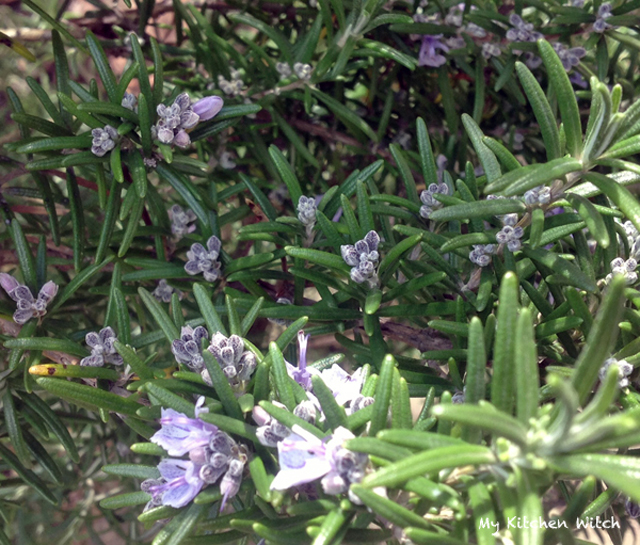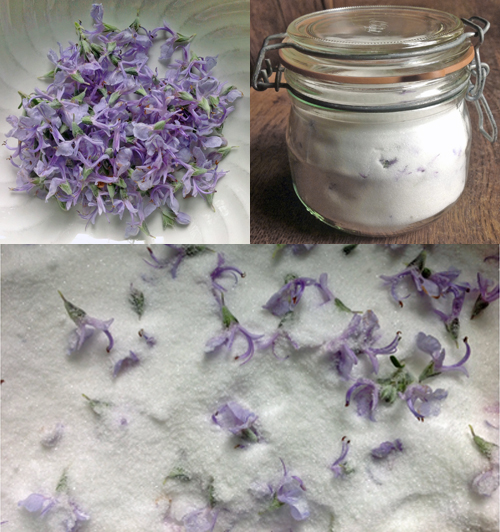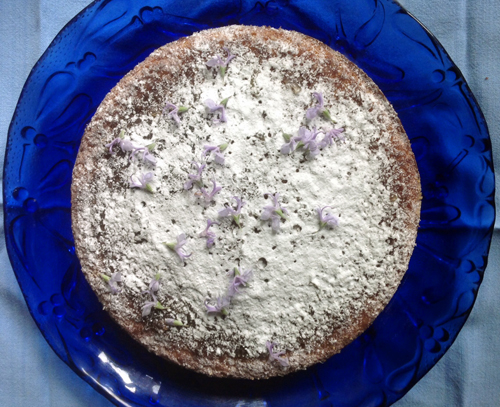A while ago, I was out in my garden taking photographs to include in my April segment of my diary post, Around My Edible Garden. One image – the newly opening purple flowers of the rosemary bush – started a train of thought around the color purple.
But, I need to backtrack a little. Just before taking that photo, I started seeing people posting lovely cakes using rosemary flowers, often showing stunning photographs of the the purple beautifully decorating the snow white icing. Striking a note somewhere in the back of my mind was the use of another purple flower in cakes – lavender. True enough, there was Diane Henry’s recipe for lavender, orange and almond cake in her fabulous book, Crazy Water Pickled Lemons. In fact, in the introduction to her chapter Fragrance of the Earth, she talks about producing lavender sugar by taking the tiny flowers and grinding them up with granulated sugar in a coffee or spice grinder to produce what she calls a floral icing sugar. So, that immediately brought me back to rosemary and rosemary sugar.
Naturally, after the rosemary sugar was made, a cake was called for. Again, Diana Henry to the rescue with her recipe for lemon and rosemary cake which inspired me to create a lemony cake using my newly made rosemary sugar.
Rosemary Sugar
Make this at least 2 weeks before use. Since rosemary flowers do not dry like lavender – the latter keep their color and shape; the former don’t – I suspected making rosemary icing sugar using Diane Henry’s lavender sugar method would result in tiny brown specks in the sugar – very unaesthetic and unapetizing. I opted instead for a simple infusion, like vanilla sugar, with the remains of the dried and browned flowers sifted out.
- Handful of rosemary flowers (approximately 1/2 cup of loose flowers, not packed)
- 2 cups sugar
Pick flowers from the rosemary bush on a dry day. Place them in a bowl of the sugar and mix. Spoon into a jar with a closely fitting lid, leaving a little headspace so that the sugar can be shaken occasionally. Leave to infuse for at least 2 weeks or more for a stronger flavor. Over time the flowers will have lost their purple color and turn brown. Sift out the flowers.
Keep the sugar sealed in a clean jar until use. The sugar produced has a delicate hint of rosemary, more floral than piney. It can be used in any sort of sweet such as cakes, cookies, ice creams and sorbets, or just sprinkling on fruit – to name a few uses that immediately come to mind. One option is the following Lemon, Polenta & Rosemary Sugar Cake.
Was it worth picking all those little flowers, waiting for the sugar to infuse, sifting out all the unsightly browned flowers? See my answer below after the cake recipe.
Lemon, Polenta & Rosemary Sugar Cake
This recipe, like Diane Henry’s lemon and rosemary cake, is based on a traditional syrup-soaked Tunisian polenta cake. It is not a unique recipe as many other cooks have produced similar cakes. But, I have modified it by substituting the oil normally used for a mixture of butter and yoghurt. Because it does not contain wheat flour, it has the benefit of being gluten free. It can also be made substituting the rosemary sugar for castor sugar to produce a simple Lemon Polenta cake.
- 1/4 cup polenta
- 1-1/4 cups ground almonds
- 1 cup rosemary sugar
- Zest of 1 lemon
- 1-1/2 teaspoon baking powder
- 1/2 cup thick Greek yoghurt
- 2 oz. (1/2 stick) butter
- 4 eggs
Preheat the oven to 350 degrees F. Prepare an 8-inch springform baking pan by lining the bottom with baking parchment and buttering the bottom and sides. Dust with a little extra polenta. Set aside while you make the batter.
In a mixer with the paddle attachment (or in a bowl by hand), cream the sugar and butter together until smooth. Add the eggs, one at a time – incorporating after each addition. Add the yoghurt. Measure out the polenta, ground almonds and baking powder. Zest and juice the lemon, setting the juice aside for use in the syrup. Finely chop the zest. Add these dry ingredients and the zest to the liquid mixture and process until incorporated. The batter will be slightly grainy due to the nature of the polenta and almonds. Pour this into the prepared pan.
Bake for 35 to 40 minutes. Meanwhile make the syrup.
Syrup
- Juice from 1 lemon
- 1/3 cup water
- 1/3 cup rosemary sugar
Put all of the ingredients into a saucepan and bring to a boil. Turn down the heat and let gently simmer for about 5 minutes to create a light syrup. Take off heat and let it cool slightly.
Take the cake out of the oven when done – test by inserting a knife into the center. If it comes out clean, it is done. Let it cool on a rack while still in its tin for about 10 minutes.
Remove the cake from the tin and place it on a serving plate. With a skewer, pierce the top of the cake all over. Pour over the syrup while the cake is still warm. Let cool completely before cutting. Dust with confectioner’s sugar just before serving.
* * *
Was it worth picking all those little flowers?
I would have to say, a provisional yes. It was easy enough to collect the rosemary flowers. It produced a lovely scented sugar, but it was very subtle – almost too subtle when baked. The flavor of the rosemary in the lemon polenta cake was mild, but the lemon was more prominent.
The cake, being mostly ground almonds (and soaked in syrup), kept its moisture very well and actually improved upon resting. A good cake to have in mind when you need to save time by preparing a dessert the day before – with or without the rosemary sugar. Next to try are peaches poached in a rosemary sugar syrup to see if the herb flavor comes through.
I probably will make rosemary sugar again, but (out of personal preference) add a sprig or two of rosemary to punch up the intensity of the herb in the sugar. Or, if I’m really being lazy, I might just cheat by infusing the sprigs instead of the flowers, no matter how alluringly seductive and prettily purple they may be. They can be saved for decoration.









Beautiful delicate picture – great idea.
LikeLike
Rosemary flowers are always a delight to see when the appear in the spring. Thanks – I thought the photo was pretty, too.
LikeLike
I will be giving this a try in the future, my similar recipes use oil and I would like to try one with butter next time. I may not get to the rosemary sugar straight away but love the idea. Really pretty photo. 🙂
LikeLike
I made the cake from Diane Henry’s recipe once – oil included – but really didn’t like the (for want of a better word) oily results. Substituting it for a little butter and yoghurt was so much better, and quite possibly cut down on a few calories. I have some more rosemary sugar on the go – this time with fresh sprigs of the herb and will, no doubt, be trying it again. It’s a good cake.
LikeLike
While reading your post, I was thinking to myself “surely a sprig of rosemary achieve the same result” then I see you reached the same conclusion. I tried a very similar cake a few weeks back, a Nigella recipe, which seemed to get better as the days passed. I’m heading out to clip a sprig of rosemary to infuse the sugar for a remake of the polenta cake. Thanks for the inspirational idea!
LikeLike
I saw that Nigella recipe as well. There are a lot of variations of it out there, but they all use oil. I much prefer the butter-yoghurt substitution, though not a good idea for those who need to avoid dairy. You are correct, the cake really comes into its own the day or even two days after it is made. I’m afraid it usually doesn’t last much longer in our house, so I can’t say what its long term properties are. Am infusing rosemary sprigs, too. Need a comparison test!
LikeLike
Love the color of the rosemary flowers, they are so beautiful and delicate. Rosemary is the only herb (at least in my garden) that lives through our summers in Bahrain and I have been growing it for some years but it has never flowered. Maybe you need to give me some tips! The cake looks wonderful and I also love to make rosemary sugar. 🙂
LikeLike
The flowers are lovely, I have to agree. Just did a quick search and it seems the general consensus is that 1. it takes maturity for a plant to flower (which yours seem to be) and 2. rosemaries have a mind of their own and flower (or not) when they want to. Not much help, really, but I do prune mine every year and notice that the flowers form on the older growth and not the new young sprigs. The cake is great and I am in the process of making rosemary sugar with sprigs of rosemary for a taste-test comparison.
LikeLike
I am sure the heat has a part to play but maybe I will prune the rosemary bush more often. Thank you for your help. The sprigs of rosemary I would imagine will impart a much stronger flavor than the flowers… depending on how much you use. 🙂
LikeLike
I would’ve never thought to have used polenta in a dessert recipe, but this sounds wonderful. Lucky for me, it also seems to be naturally gluten free. Love the inclusion of the rosemary flowers, Greek yogurt, and ground almonds. Will have to try this when we get ‘home.’ 🙂
LikeLike
There are a lot of similar recipes out there – some use polenta and others use semolina, some are lemon, some are orange, some mix lemon and orange… But, they are all basically the same in concept. I’ll be trying this again with a new batch of rosemary sugar infused with the fresh sprigs of the herb. Next…thyme sugar! Another blogger also just told me that in Germany they have rose sugar. All sorts of sugars we get to play with!
LikeLike
Love the use of fresh herbs to add an infusion of natural flavor! I’m definitely eager to try out polenta for this recipe. I’ve used it for savory breads, but the dessert twist is a new one. 🙂 Thanks again for the inspiration!
LikeLike
Rosemary is one of my favourite herbs and I use it judiciously but liberally in both sweet and savoury food. I suppose that the flowers just aren’t infused with the same strength of flavour as a lavender flower – such a shame. I think that a rosemary infused sugar solution would make a lovely thin crunchy topping to this cake and possibly hold more of it’s flavour too…I have a recipe on my site for a Lemon and Semolina Cake with Saffron which I adapted from Nigella’s polenta cake. It is one of the most viewed recipes on my blog…
LikeLike
The flower infused sugar smelled heavenly, but the lemon in the cake really overpowered it. I have higher hopes using it to poach fruit – particularly peaches. I’ll have to take a look at your cake recipe. It sounds really good. One thing I didn’t like about all those similar recipes out there (including Nigella’s) was the quantity of oil used – hence my substitution of butter and yoghurt which worked like a dream. I’m still going to attempt making this with a rosemary sugar made from infused sprigs – might make a difference.
LikeLike
Just had a look at your cake recipe – looks good enough to eat! I see you also went for the non-oil option and used butter instead. Lovely!
LikeLike
Oh, how funny – I just went over to check whether I had used oil because I just couldn’t remember! It’s a great tasting cake, keeps well and is better the next day too, like yours!
LikeLike
I love reading about your experiments and ideas. I’ve seen rose sugar sold here and bought some for friends, but I wasn’t sure what I’d do with it besides look at how beautiful it was. These purple flowers are beautiful, and I love rosemary, so I think I’d love this infused sugar. Inspiring ideas!
LikeLike
Rose sugar? It even sounds pretty. I suppose you could you could use it with things that rose water would go well with. I’m also thinking of thyme sugar, but am waiting until the bushes are in bloom as the herb is supposed to be at its fragrant best at that time. I love experimenting, often falling flat on my face, but that’s all part of the process. However, the cake worked beautifully and I am going to make it again with sugar infused with rosemary sprigs to see if there is a significant difference.
LikeLike
Sounds heavenly!
LikeLike
The cake was lovely, but I want to try it again with a stronger infusion of rosemary. Great that the cake is gluten free, too.
LikeLike
Everything looks so gorgeous!
LikeLike
The delicate purple of the rosemary flowers are so pretty, I couldn’t resist making something with them. The aroma of the infused sugar is heavenly and the taste is very subtle.
LikeLike
Great idea… And cake! I love as well not to waste aromatic flowers, i used thyme flowers for the savoury cookies, last year i made an infused oil with basil flowers… And now i’ll try your sugar! 🙂
LikeLiked by 1 person
I’m trying a new batch of rosemary sugar made with. the sprigs of the herb. Next to try is thyme sugar. As you can tell, I’m enjoying my herb garden!
LikeLike
I’ve learned so much from this post. I didn’t know that those little flowers were rosemary. Rosemary could be my favorite plant.
LikeLike
They are lovely flowers. I guess I am lucky as many people are not able to get their rosemary plants to flower. I did some internet research on this and discovered that rosemary seems to have a mind of its own whether or not it will flower or even when it will flower. Though, the plant needs maturity, so if you have a young plant, it may flower once it gets older,
LikeLike
Thank you for the inspiration! I’ve got tons of fresh rosemary in my yard. I just never thought to combine it with sugar. Great idea!
LikeLike
I got the idea originally from Diana Henry in her cookbook, Crazy Water Pickled Lemons where she uses herbs quite a lot in sweets. Lemon and rosemary is a great combination. Glad you were inspired!
LikeLiked by 1 person
I love this idea of rosemary sugar, and the cake looks wonderful!
LikeLike
I’m making more – this time with infused sprigs. Just had a sniff and it’s glorious! Another cake to follow soon.
LikeLike
[…] Last year, I experimented infusing sugar with the lightly scented flowers, but the resulting rosemary sugar proved to be too subtle and the scent was lost when it was used in baking. So, this year, if I use […]
LikeLike